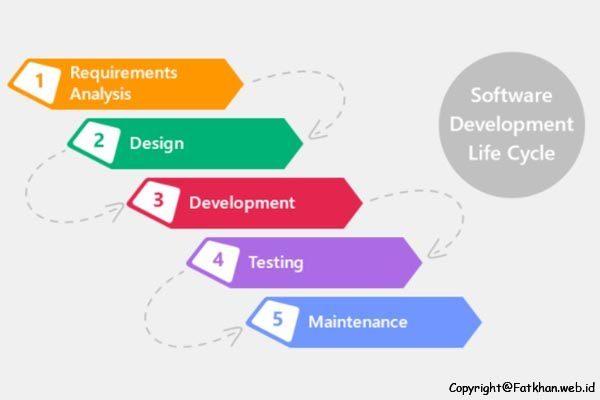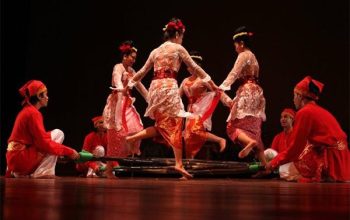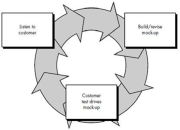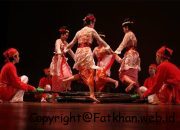Software Development using the Waterfall Method – Software Engineering (SE) is a profession that focuses on the development of software, including its creation, maintenance, organizational management, and quality management. The IEEE Computer Society defines software engineering as the systematic, disciplined, and quantifiable approach to the development, use, and maintenance of software, as well as the study of these approaches, i.e., the application of engineering principles to software.
Software Engineering involves modifying software itself to develop, maintain, and rebuild it using engineering principles to create software that can work more efficiently and effectively for users. The following criteria can be used as references in software engineering:
- Maintainability: The software should be easily maintained and updated without significant effort or disruption.
- Dependability: The software should be able to adapt to technological advancements and changes without compromising its reliability and stability.
- Robustness: The software should be able to handle unexpected situations or errors gracefully, ensuring that it continues to function properly.
- Efficiency: The software should be designed to optimize energy usage and resource utilization, ensuring it operates effectively and efficiently.
- Usability: The software should meet the needs and expectations of its users, providing a user-friendly interface and intuitive functionality.
By following these criteria, software engineers can develop high-quality software that meets the requirements and expectations of users while being maintainable, adaptable, robust, efficient, and user-friendly.
Understanding the Waterfall Method
The Waterfall Method is a sequential and linear approach to software development. It follows a structured flow of phases, where each phase is completed before moving on to the next one. The key characteristics of the Waterfall Method include:
- Sequential Flow: The development process progresses in a step-by-step manner, with each phase being completed before the next one begins. There is no overlapping or iteration between phases.
- Requirements Analysis: The initial phase involves gathering and documenting the requirements of the software. This includes understanding the needs of the users and defining the scope of the project.
- Design: Once the requirements are defined, the design phase begins. This involves creating the architectural design, system design, and detailed design of the software.
- Implementation: In this phase, the actual coding and development of the software take place. The design specifications are translated into executable code.
- Testing: After the implementation phase, the software is thoroughly tested to ensure that it meets the specified requirements and functions as intended.
- Deployment: Once the software passes the testing phase, it is deployed and made available to the end-users.
- Maintenance: The final phase involves ongoing maintenance and support of the software. This includes bug fixes, updates, and enhancements based on user feedback.
The Waterfall Method provides a structured and well-documented approach to software development. It is suitable for projects with well-defined requirements and a stable environment. However, it may not be suitable for projects where requirements are likely to change or evolve during the development process. The lack of flexibility and adaptability can make it challenging to accommodate changes or address issues that arise later in the project.
Stages of the Waterfall Method
The Waterfall Method consists of several distinct stages that are followed sequentially. These stages include:
- Requirements Gathering: In this stage, the software development team works closely with stakeholders to identify and document the project’s requirements. This involves understanding the needs of the users, defining the scope of the project, and creating a detailed requirements specification.
- System Design: Once the requirements are gathered, the system design phase begins. In this stage, the software architecture is designed, and the overall system structure is defined. This includes identifying the different modules or components of the software and their relationships.
- Implementation: The implementation stage involves writing the actual code for the software based on the system design. Programmers and developers work to translate the design specifications into executable code. This stage also includes integrating different modules and components to create a functioning software system.
- Testing: After the implementation is complete, the software undergoes rigorous testing to ensure that it meets the specified requirements and functions correctly. This stage includes various types of testing, such as unit testing, integration testing, system testing, and user acceptance testing.
- Deployment: Once the software has been thoroughly tested and deemed ready for release, it is deployed to the end-users or customers. This stage involves installing the software on the intended hardware or infrastructure and making it available for use.
- Maintenance: The final stage of the Waterfall Method is maintenance. This involves providing ongoing support, bug fixes, updates, and enhancements to the software to ensure its continued functionality and usability. Maintenance may also involve addressing any issues or feedback received from users.
It’s important to note that in the Waterfall Method, each stage is completed before moving on to the next one, and there is little to no room for iteration or changes once a stage is completed. This sequential nature of the Waterfall Method can be beneficial for projects with well-defined requirements but may pose challenges if there are changes or new requirements that arise during the development process.
Advantages of the Waterfall Method
The Waterfall method is a traditional project management approach that follows a linear and sequential process. While it may not be suitable for all projects, it does offer some advantages in certain situations. Here are some advantages of the Waterfall method:
- Clear and well-defined project scope: The Waterfall method requires detailed planning and documentation upfront, including defining project requirements and scope. This helps ensure that everyone involved has a clear understanding of the project goals and deliverables.
- Sequential and structured approach: The Waterfall method follows a step-by-step approach, where each phase is completed before moving on to the next. This structured approach provides a clear roadmap and helps maintain project discipline.
- Easy to understand and manage: The linear nature of the Waterfall method makes it relatively easy to understand and manage. It allows for clear project tracking and progress monitoring, as each phase has specific deliverables and milestones.
- Well-suited for stable requirements: The Waterfall method works well when project requirements are stable and unlikely to change significantly during the development process. It is effective for projects with clear and predictable outcomes.
- Documentation-focused: The Waterfall method emphasizes thorough documentation at each phase of the project. This documentation helps in knowledge transfer, future maintenance, and compliance requirements.
- Suitable for small teams: The Waterfall method is often used for projects with smaller teams and limited resources. It allows team members to focus on their specific tasks without much overlap or dependency on others.
- Effective for projects with fixed deadlines: If a project has a fixed deadline, the Waterfall method can be beneficial. The sequential nature of the method allows for better planning and estimation of timeframes, making it easier to meet project deadlines.
It’s important to note that the Waterfall method may not be suitable for projects with evolving requirements, complex dependencies, or a need for frequent collaboration and feedback. In such cases, more flexible and iterative approaches like Agile or Scrum may be more appropriate.
Disadvantages of the Waterfall Method
While the Waterfall method has its advantages, it also has some disadvantages that need to be considered. Here are some of the disadvantages of the Waterfall method:
- Lack of flexibility: The Waterfall method follows a sequential and linear approach, where each phase is completed before moving on to the next. This lack of flexibility makes it difficult to accommodate changes or new requirements that may arise during the project. Any changes in requirements may require going back to earlier phases, leading to delays and increased costs.
- Limited customer involvement: The Waterfall method typically involves minimal customer involvement during the development process. Customer feedback and requirements are gathered upfront, and any changes or feedback may be difficult to accommodate once the project is in progress. This can result in a final product that may not fully meet the customer’s needs or expectations.
- Higher risk of project failure: Since the Waterfall method relies on upfront planning and documentation, there is a higher risk of project failure if the initial requirements or assumptions are incorrect. If critical issues or challenges are discovered late in the project, it may be difficult or costly to make necessary adjustments.
- Longer time to deliver value: The Waterfall method requires completing each phase before moving on to the next, which can result in longer delivery times. This can be a disadvantage in fast-paced industries or projects where quick value delivery is essential.
- Limited collaboration and communication: The Waterfall method often involves limited collaboration and communication between team members and stakeholders. The linear nature of the method can lead to siloed work and a lack of interaction between different project phases or team members.
- Difficulty in managing complex projects: The Waterfall method may not be suitable for complex projects with multiple dependencies and interrelated tasks. The lack of flexibility and adaptability can make it challenging to manage and coordinate such projects effectively.
- Limited room for error: Since the Waterfall method follows a sequential approach, any errors or issues discovered late in the project may require significant rework or even restarting the project from the beginning. This can lead to increased costs and delays.
It’s important to carefully assess the project requirements and characteristics before deciding to use the Waterfall method. For projects with evolving requirements, high uncertainty, or a need for frequent collaboration and feedback, alternative project management approaches like Agile or Scrum may be more suitable.
Implementation of the Waterfall Method in Everyday Life
While the Waterfall method is primarily used in project management, some of its principles can be applied to everyday life situations to improve organization and efficiency. Here are some ways you can implement the Waterfall method in your daily life:
- Goal setting: Start by clearly defining your goals and objectives. This could be personal goals, such as learning a new skill or completing a project, or professional goals, like advancing in your career. Clearly articulating your goals will help you stay focused and motivated.
- Planning and prioritization: Break down your goals into smaller, manageable tasks or milestones. Prioritize these tasks based on their importance and urgency. Create a timeline or schedule to allocate specific timeframes for each task.
- Sequential execution: Follow a step-by-step approach to complete your tasks. Start with the first task and finish it before moving on to the next one. This will help you maintain focus and avoid getting overwhelmed by multiple tasks at once.
- Documentation and tracking: Keep track of your progress by documenting your tasks and milestones. This can be done using a to-do list, a planner, or a project management tool. Regularly update your progress and check off completed tasks to stay organized and motivated.
- Adaptation and reflection: While the Waterfall method may not emphasize flexibility, it’s important to adapt and reflect on your progress. Regularly review your goals and tasks to ensure they are still aligned with your priorities. If necessary, make adjustments or re-prioritize tasks based on changing circumstances or new information.
- Time management: Efficient time management is crucial when implementing the Waterfall method in everyday life. Set realistic deadlines for each task and allocate dedicated time slots to work on them. Avoid multitasking and focus on one task at a time to maintain productivity and quality.
- Celebrate achievements: Once you complete a task or milestone, take a moment to acknowledge and celebrate your achievement. This will help you stay motivated and reinforce a sense of progress and accomplishment.
Remember that the Waterfall method may not be suitable for all aspects of your daily life. It’s essential to assess the nature of the task or goal and determine whether a more flexible or iterative approach, such as Agile, may be more appropriate. Adapt the principles of the Waterfall method to fit your specific needs and preferences.












